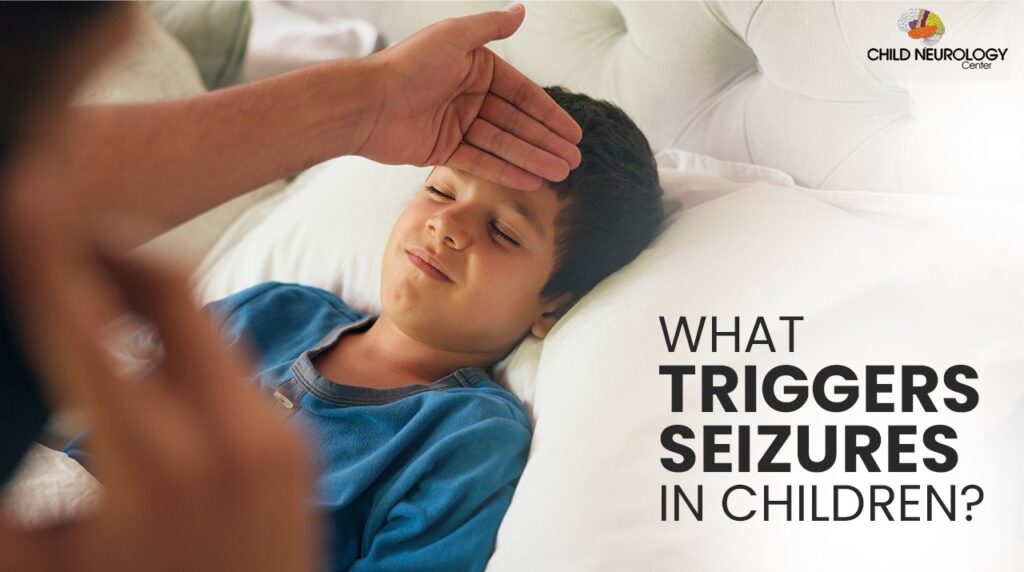
By child-neurology | In Child Health
Seizures in children can be alarming for parents, especially when they occur unexpectedly. However, understanding the underlying causes can help you identify potential risks and seek appropriate treatment quickly.
Seizures are often the result of electrical disturbances in the brain, but they can be triggered by a variety of factors. Some triggers are temporary and may not recur, while others could signal a more persistent or chronic condition, such as Epilepsy. Here’s a deeper look at what could trigger a seizure in your child:
1. High Fever (Febrile Seizures)
One of the most common causes of seizures in young children is a high fever, often seen in infants and toddlers between the ages of 6 months and 5 years. These are known as febrile seizures and typically occur when a child’s temperature rises rapidly.
Why it happens: The brain’s temperature-regulating system may react to a sudden increase in body temperature, causing abnormal electrical activity and triggering a seizure.
What you should know: Febrile seizures are usually short (lasting less than 5 minutes) and often do not indicate a long-term neurological issue. However, if your child experiences a febrile seizure, it’s crucial to contact a pediatrician to rule out any serious infection.
2. Head Trauma or Concussion
A head injury—whether from a fall, bump, or more serious trauma—can disrupt the brain’s normal electrical activity, leading to seizures.
Why it happens: When the brain is injured, it can cause swelling or irritation in certain brain areas, which can trigger a seizure. Children who have suffered concussions or significant head trauma are at higher risk of post-traumatic seizures.
What you should know: After any head injury, closely monitor your child for signs of a seizure or other neurological issues, such as confusion, dizziness, or difficulty focusing. If a seizure occurs, seek immediate medical attention.
3. Low Blood Sugar or Electrolyte Imbalance
Seizures can also be triggered by hypoglycemia (low blood sugar) or an imbalance of essential electrolytes like sodium or calcium.
Why it happens: Blood sugar is a vital source of energy for the brain. When blood sugar levels drop too low, brain function can become impaired, sometimes leading to seizures. Similarly, imbalances in electrolytes can disrupt brain electrical activity and provoke a seizure.
What you should know: Ensure your child maintains regular meals and snacks to avoid drops in blood sugar. Dehydration, excessive sweating, or diarrhea can also cause electrolyte imbalances. In cases where a seizure occurs due to a known medical condition (like diabetes), speak to your healthcare provider about managing your child’s condition.
4. Infections (Like Meningitis or Encephalitis)
Serious infections affecting the brain or its surrounding structures, such as meningitis (inflammation of the brain’s protective membranes) or encephalitis (brain inflammation), can lead to seizures.
Why it happens: Infections cause inflammation and swelling in the brain, which disrupts normal electrical impulses. This can cause fits or seizures, especially in younger children.
What you should know: Infections often come with other symptoms like fever, vomiting, headaches, and neck stiffness. If your child shows signs of infection and experiences a seizure, it’s crucial to get them to the hospital immediately for diagnosis and treatment.
5. Lack of Sleep or Extreme Fatigue
Severe fatigue or sleep deprivation can trigger seizures in children, especially those who are already prone to them.
Why it happens: The brain requires rest to function properly. When a child doesn’t get enough sleep, the electrical activity in their brain may become disorganized, which can lead to seizures. Extreme exhaustion or stress can also have a similar effect.
What you should know: Ensuring your child has a consistent sleep schedule and enough rest is important for brain health. Stressors like long days at school or lack of sleep during travel can trigger seizures, so be mindful of their routine.
6. Genetic or Structural Brain Issues
In some cases, a child’s brain may have genetic conditions or structural abnormalities that predispose them to seizures.
Why it happens: Conditions like genetic epilepsy syndromes, where the brain’s electrical activity is inherently abnormal, can make children more prone to seizures. Additionally, structural problems in the brain, such as brain tumors or developmental brain malformations, can also disrupt normal brain function and cause seizures.
What you should know: If seizures are recurrent or occur without a clear cause, it’s important to consult a best child neurologist. Genetic or structural issues often require long-term management and specialized treatment.
What Should You Do If Your Child Has a Seizure?
If your child experiences a seizure, stay calm and ensure their safety. Here’s what you can do:
- Protect them from injury: Move them away from sharp objects, and cushion their head if possible.
- Do not put anything in their mouth: This can cause injury or choking.
- Time the seizure: If it lasts more than 5 minutes, seek emergency medical help immediately.
- Comfort them after: Once the seizure stops, keep your child calm and comfortable. They may be confused or tired after the event.
Conclusion
Understanding the triggers for seizures can help you identify potential risks and act quickly. In some cases, seizures are isolated events that don’t lead to long-term issues. In others, they may signal a chronic condition like Epilepsy. It’s essential to seek guidance from a best pediatric neurologist if your child has more than one seizure or if a seizure is triggered by a serious underlying issue. Early intervention is key to managing and preventing future seizures.


